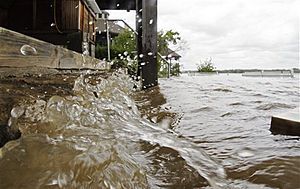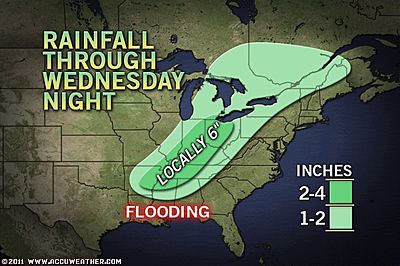
The rising waters are expected to top levels set during February 1937. This mark is the middle Mississippi Valley's equivalent to the 1993 event farther north along Old Man River.
Even if rain were to fall at a normal rate for the remainder of the spring, the consequences of what has already happened in the Midwest will affect way of live, property, agriculture and travel/shipping/navigation for weeks in the region.
While the amount of evacuees currently numbers in the hundreds, it could soon number in the tens of thousands as levees are topped or breached and rivers expand their girth into more farming communities, towns and cities.
The flooding problem is not only for the major rivers in the long term, but flooding could repeat later this season for the smaller rivers feeding into the Mississippi and Ohio rivers as well as the multitude of small streams that feed into the rivers.
The Black River flooded areas around Poplar Bluff, Mo., while rising waters along a stream overtook the town of Johnson, Ark., early this week.
A several-day stretch of rain-free weather is forecast by AccuWeather.com meteorologists to continue into the first part of the weekend. However, more rain and perhaps severe thunderstorms may return by early next week.
River levels at Cairo, Ill., Tiptonville, Tenn., and several other locations are forecast by National Weather Service hydrologists to set new record highs this weekend.
Cairo, Ill., lies along the banks of where the Mississippi and Ohio rivers meet.
A general 6 to 12 inches of rain have fallen on portions of southeastern Missouri, southern Illinois, western Kentucky, Arkansas, Indiana, Ohio and western Tennessee this month. However, there have been much higher amounts locally.
Cape Girardeau, Mo., has received over 19 inches of rain so far this month, which is over five times that of normal for the entire month of April. 14.50 inches of rain have fallen in five days in the city along the Mississippi River.
Cincinnati, Ohio has received over a foot of rain, which around four times its normal rainfall for the entire month.
Record- or near-record water levels are taxing levees in the region.
The stress on the levees in some locations will not only last days but weeks as the huge rivers such as the Mississippi and Ohio take much longer to fall below flood stage than smaller rivers.
The Army Corps of Engineers was preparing to breach the levee at Birds Point, Mo., in order to possibly prevent a levee breach at Cairo, Ill. It is believed this may take some of the pressure off the levee protecting the city.
The planned breach has prompted a court battle between the Corps and the Missouri attorney general Thursday.
Although not forecast to reach record levels, there are other stretches of the Mississippi River farther north and south, and a large part of the Ohio River farther to the east that have been and will continue to remain well above flood stage.
The high water and saturated ground will delay the planting of crops.
Fortunately, the growing season in this region is long and evaporation rates will continue to increase into the first part of the summer.
The region and the souls that work the land are notorious for bouncing back after spring flooding, provided conditions turn favorable in the month or two ahead.
What's Ahead?
The additional rainfall today in southern and eastern areas will raise stream levels in these areas and may add to already high levels of rivers.
While a break of dry weather is coming later in the week into the weekend, the atmosphere is probably not yet done dishing out heavy rainfall (and severe thunderstorms) for the region.
As a pocket of chilly air develops in the Northeast during the first part of May, the battle zone may still lie over the Midwest, where the warm, moist air continues to charge in from the South and rise violently, forming the relentless downpours and big storms.
While the rainfall forecast during May will probably not sustain the flood levels at present or soon to be experienced, it could continue to produce well above average stream flows and river levels above flood stage through much of the balance of the spring.
In addition the weather pattern will favor, at the very least, episodes of flash and small stream flooding on a local basis in the region through much of May.
With the shift in the cool pocket and further confrontations with warmth and chill, there may be an increase in risk of storms with severe weather and flooding farther north over the Midwest, than what we have seen so far this spring.
The surge of high water will also continue to work downstream in the weeks ahead, reaching areas from Memphis to New Orleans.




Reader Comments
to our Newsletter